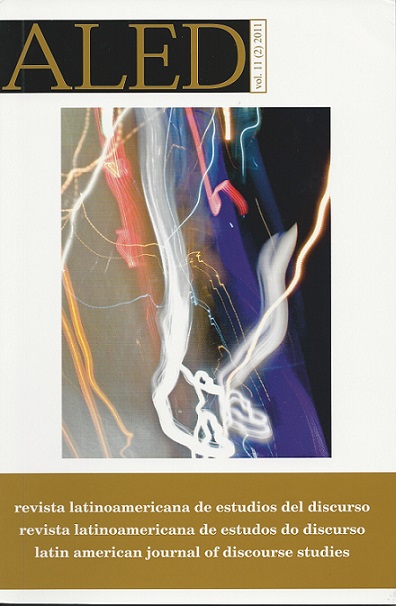Práticas de linguagem na atividade de trabalho
cenografia e ethos em discursos socioprofissionais
Keywords:
discourse practices. language at work. enunciative scenography. discursive ethos.Abstract
The aim of this study is to contribute to the understanding of discourse practices in corporations as seen through the internal company newspaper and the language of professionals who work in the internal communication of organizations. Language is understood here as the result of human activity in the world, as a discourse act that situates us and which has a fundamental role with respect to interdisciplinary studies that focus on the world of language from an ergological perspective (Swchwartz, 1994, 1997, 2010) and discourse analysis based on enunciation (Maingueneau, 2001, 1984, 2008a, 2008b). The methodological procedures fall into the qualitative analysis techniques, particularly the evidentiary method (Ginzburg, 1989). The study showed that the discursive ethos is embedded in the scene constituted by the enunciation through which a particular status is established by means of statements that allow us to understand language as a sociohistorical fact inserted in the power relations that permeate society.
Downloads
References
AMOSSY, R. (2008). ‘O ethos na interseção das disciplinas: retórica, pragmática, sociologia dos campos’, in R. Amossy (org.). Imagens de si no discurso: a construção do ethos. 1. ed., 1a reimpressão, pp. 119-144. São Paulo: Contexto.
AROUCA, M. A. & AROUCHE; I. M. P. & MELLO, E. E. (1998). ‘As imagens da empresa nas entrevistas’, The ESPecialist, São Paulo, PUC-SP/LAEL, 19, num. especial: 305-316.
BENVENISTE, É. (1966/1995). ‘Estrutura das relações de pessoa no verbo’, in É. Benveniste. Problemas de lingüística geral I, pp. 247-259, 4. ed. Campinas, SP: Pontes, Editora da Universidade Estadual de Campinas.
BENVENISTE, É. (1974/1989). ‘A linguagem e a experiência humana’, in É. Benveniste. Problemas de linguística geral II, pp. 68-80. Campinas, SP: Pontes, 1989.
CHARAUDEAU, P. & MAINGUENEAU, D. (2008). Dicionário de análise do discurso. Coordenação da tradução Fabiana Komesu. 2. ed., 2a reimpressão. São Paulo: Contexto.
DURAFFOURG, J. (2010). ‘O trabalho e o ponto de vista da atividade’, in Y. Schwartz & L. Durrive (orgs.). Trabalho & Ergologia: conversas sobre a atividade de trabalho, pp. 47-82. Niterói: EDUFF.
DURAFFOURG, J.; DURRIVE, L. (2003/2010). ‘O trabalho e o ponto de vista da atividade’, in Y. Schwartz & L. Durrive (orgs.). Trabalho e Ergologia: conversas sobre a atividade de trabalho, pp. 47-82. Niterói: EDUFF.
FREITAS, E. C. (2011). ‘A enunciação em texto jornalístico: o uso das categorias de tempo, espaço e pessoa’, ReVEL, 9 (16): 1-25.
GINZBURG, C. (1989). Mitos, emblemas, sinais: morfologia e história. São Paulo: Cia. das Letras.
MAINGUENEAU, D. (1997). Novas tendências em análise do discurso. Tradução Freda Indursky. 3. ed. Campinas, SP: Pontes: Editora da Universidade Estadual de Campinas.
MAINGUENEAU, D. (2001). Análise de textos de comunicação. Tradução de Cecília P. de Souza-e-Silva, Décio Rocha. São Paulo: Cortez.
MAINGUENEAU, D. (1984/2008a). Gênese dos discursos. Tradução Sírio Possenti. São Paulo: Parábola Editorial.
MAINGUENEAU, D. (2008b). ‘Ethos, cenografia, incorporação’, in R. Amossy (org.). Imagens de si no discurso: a construção do ethos. 1. ed., 1a reimpressão, pp. 69-92. São Paulo: Contexto.
MAINGUENEAU, D. (2008c). ‘A propósito do ethos’, in A. R. Motta, & L. Salgado (orgs.). Ethos discursivo, pp. 11-29. São Paulo: Contexto.
MUSSALIM, F. (2008). ‘Uma abordagem discursiva sobre as relações entre ethos e estilo’, in A. R. Motta & L. Salgado (Orgs.). Ethos discursivo, pp. 70-81. São Paulo: Contexto.
SANT’ANNA, V. L. A . (1998). ‘O jornal de empresa e a construção de imagens’, The ESPecialist, PUC-SP/LAEL, 19 (n. Especial): 277-286.
SANT’ANNA, V. & SOUZA-E-SILVA, M. C. P. (2007). ‘Trabalho e prescrição: aproximação ao problema a partir dos estudos da linguagem’, Revista Matraga, 14 (20): 77-99.
SCHWARTZ, Y. (1994). Travail et philosophie: convocations mutuelles. Toulouse: Octares.
SCHWARTZ, Y. (1995). De l’inconfort intelllectuel, ou: comment penser les activités humaines? Collection Le Présent Avenir: Paris.
SCHWARTZ, Y. (org.) (1997). Reconnaissances du travail. Pour une approche ergologique. Paris: PUF.
SCHWARTZ, Y. (2002). ‘A abordagem do trabalho reconfigura nossa relação com os saberes acadêmicos: as antecipações do trabalho’, in M. C. P. Souza-eSilva & D. Faïta (Orgs.). Linguagem e trabalho: construção de objetos de análise no Brasil e na França, pp. 109-126. São Paulo: Cortez.
SCHWARTZ, Y. (2003). ‘Trabalho e saber’, Trabalho & Educação, Revista do NETE, Belo Horizonte, 12 (1): 21-34. jan./jun.
SCHWARTZ, Y. (2010). ‘Trabalho e uso de si’, in Y. Schwartz & L. Durrive (orgs.). Trabalho & ergologia: conversas sobre a atividade humana, pp. 189-206. Niterói: EdUFF.
SCHWARTZ, Y. & DURRIVE, L. (Orgs.). (2003/2010). ‘Trabalho e uso de si’, in Y. Schwartz & L. Durrive (orgs.). Trabalho e Ergologia: conversas sobre a atividade humana, pp. 189-204. 2. ed. Niterói: EdUFF.
SENNET, R. (2006). ‘Les failles culturelles du nouveau capitalisme’, Sciences Humaines, 176: 38-39.
SILVA, E. G. (2006). 293 f. Os (des)encontros da fé ”“ análise interdiscursiva de dois movimentos da Igreja Católica. Tese doutorado ”“ Instituto de Estudos da Linguagem da Universidade Estadual de Campinas (SP).
SOUZA-E-SILVA, M. C. P. (2004). ‘Quais as contribuições da lingüística aplicada para a análise do trabalho?’, in M. Figueiredo & M. Athayde & J. Brito & D. Alvarez (orgs.). Labirintos do trabalho: interrogações e olhares sobre o trabalho vivo, pp. 188-213. Rio de Janeiro: Editora DP & A.
SOUZA-E-SILVA, M. C. P. (no prelo). ‘Sistemas de ensino ”“ mudanças na Educação e no trabalho do professor?’, Linguística Aplicada e Sociedade: 1-18.
TEIXEIRA, M. (2010). ‘Dimensão subjetiva da atividade de trabalho: um olhar multidisciplinar’, Correio APPOA: temática, Porto Alegre, mar.: 45-53.
TRINQUET, P. (2010). ‘Trabalho e educação: o método ergológico’, Revista HISTEDBR On-line, Campinas, ago (número especial): 93-112.
Downloads
Published
How to Cite
Issue
Section
License

This work is licensed under a Creative Commons Attribution-NonCommercial-NoDerivatives 4.0 International License.
The authors retain the copyright and guarantee RALED the right to be the first publication of the work as well as a Creative Commons Attribution License that allows others to share the work with recognition of authorship and the initial publication in this journal.




